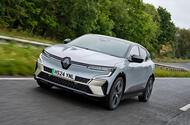
French firm’s traditional hatchback gains range-extending upgrades and enhanced interior tech
When the all-electric Renault Mégane launched in 2022, it couldn't have been more different from the cars that preceded it in the lineage.Here was a five-door hatchback styled by Gilles Vidal made to look like a concept SUV, powered only by electricity and shared almost nothing mechanically with previous generations. On top of this, it began a new family look for Renault models; a legacy that has since been continued with models such as the Scenic, Symbioz and Captur.But the Mégane had some shortcomings which meant it couldn't match its established competitors such as the Cupra Born, Kia Niro EV, and MG 4 - all of which have been updated in one way or another to make themselves more efficient and therefore competitive.But while it never had a problem standing out in simple, kerbside terms compared to those cars, it was the Mégane's only-average efficiency and range, its limited rearwards visibility, and some elements of its driving experience that made it uncompetitive for the class.Renault has introduced a round of upgrades for 2024 to address some of these issues. Along with a price drop, a heat pump is fitted to all cars as standard, boosting claimed range by up to 9%. A standard 12.0in infotainment touchscreen also replaces the old 9.0in display, and all cars now get 'contextual' adaptive cruise control (which adjusts speed according to sharp bends or roundabouts). How, then, does this new technology translate in the real world?Range at a glanceIn the UK, at least, Mégane buyers don’t get a lot of choice. It’s offered with just one battery size (60kWh) and one motor. A 40kWh variant is available elsewhere, though. There are three trim levels: Evolution, Techno and Iconic.ModelPowerEV60*214bhp*Version tested

